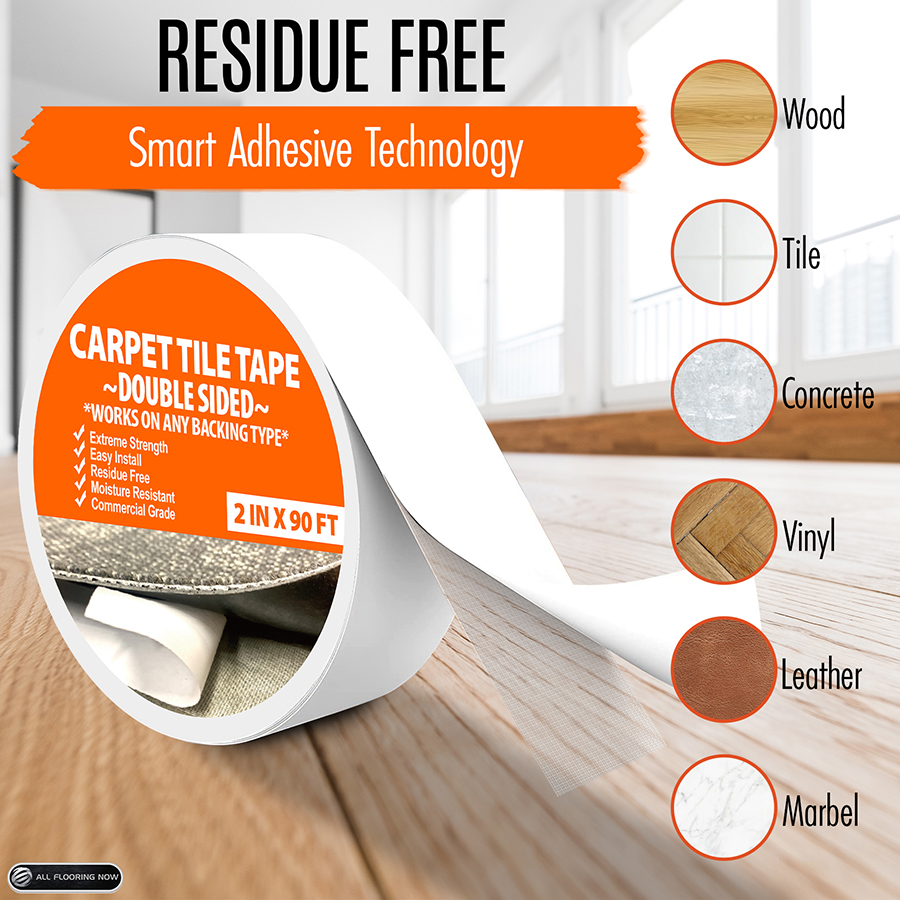Do You Put Anything Under Carpet Tiles?
Share
Whether you should put something under carpet tiles depends on several factors, including the subfloor condition, noise reduction needs, comfort preferences, and the environment. If you are looking for something to use for installing carpet tiles then carpet tile tape is a great solution. Let’s break down these considerations:
1. The Type of Subfloor
The type of subfloor you’re working with is one of the biggest factors in determining whether you need an underlayment for your carpet tiles.
- Concrete Subfloor: Carpet tiles are often installed directly on concrete, especially in commercial spaces or basements. In these cases, the tiles’ backing usually provides enough cushioning, and an underlay may not be necessary. However, in some situations, especially where moisture is a concern, an additional layer of moisture barrier or insulation may be required.
- Wood Subfloor: Carpet tiles can be installed directly over a wood subfloor but, you may need to consider using an underlayment, particularly for soundproofing or added insulation. Wood floors can creak or allow noise to travel between floors, and an underlayment can help minimize this.
- Tile or Laminate Subfloor: In most cases, you can install carpet tiles directly on top of hard flooring materials like tile or laminate. However, if the surface is uneven or cracked, you may want to use a thin underlayment to smooth it out and protect the carpet tiles from wear over time.
2. Comfort and Cushioning
If comfort underfoot is a priority, using an underlayment can make a significant difference. While some carpet tiles come with a built-in cushion, others do not. In residential settings or areas where people will be standing or walking for long periods, adding an underlay can increase the softness and provide extra comfort.
- Rubber Padding: Rubber underlayment is another option that adds both comfort and durability. It can also serve as a moisture barrier in damp environments like basements.
3. Soundproofing
Carpet tiles alone do provide some noise reduction, but in areas where soundproofing is essential, an additional layer may be necessary. This is especially true in multi-story buildings where noise from foot traffic, conversations, or other activities can travel between floors.
- Acoustic Underlay: Soundproofing underlayment, often made from materials like dense rubber or foam, can significantly reduce noise transmission. In offices, apartment buildings, or homes with second floors, this is a common solution to create a quieter environment.
- Cork Underlay: Cork is another soundproofing option that not only reduces noise but is also environmentally friendly. It’s a renewable material and provides excellent thermal insulation as well.
4. Moisture Control
Moisture is a significant factor when deciding whether to place something under your carpet tiles, particularly in areas like basements or concrete subfloors. Excess moisture can damage carpet tiles, lead to mold or mildew, and reduce the longevity of your flooring.
- Moisture Barrier: In damp environments, a moisture barrier (like plastic sheeting) can be placed under the carpet tiles to protect them from absorbing water. This is crucial for basements, bathrooms, and kitchens, or any area prone to humidity or spills.
- Vapor Barrier: Some carpet tiles come with a built-in vapor barrier, but if they don’t, and moisture is a concern, installing a vapor barrier can help prevent water from seeping up from the subfloor.
5. Thermal Insulation
Carpet tiles can feel cold, particularly when installed over concrete or in basements. If you want to make the space warmer and more comfortable, an insulating underlayment can be added.
- Insulating Foam or Felt: Thermal underlays, typically made from foam or felt, can help retain warmth and create a more comfortable environment. This is especially beneficial in cold climates where heat retention is important.
Pros and Cons of Using Underlayment for Carpet Tiles
Pros:
- Enhanced Comfort: Adding an underlayment provides extra cushioning, making the floor feel softer and more comfortable, which is important in residential settings or spaces with significant foot traffic.
- Soundproofing: An underlayment can significantly reduce the transmission of noise, especially between floors in multi-level homes or buildings.
- Moisture Protection: Underlays designed as moisture barriers protect carpet tiles from water damage, mold, and mildew, prolonging their lifespan.
- Improved Insulation: Thermal underlays can make a room warmer by providing insulation, which can reduce energy costs in colder climates.
- Evening Out Imperfections: If the subfloor is slightly uneven or cracked, an underlayment can help create a smoother surface for your carpet tiles, preventing wear and tear over time.
Cons:
- Additional Cost: Using an underlayment adds to the overall cost of your flooring project. You’ll need to budget for both the material and, potentially, the labor to install it.
- Reduced Tile Adhesion: Some underlayments can affect the adhesive used for carpet tiles, particularly in glue-down installations. You’ll need to ensure compatibility between the underlay and the adhesive to prevent tiles from shifting or loosening.
- Extra Installation Step: Installing an underlayment adds an extra step to the process, which can increase the overall time and complexity of the project.
- Height Increase: Adding underlayment will raise the height of the floor slightly, which can cause issues with door clearance or transitioning between different types of flooring.
Conclusion: Should You Use Anything Under Carpet Tiles?
Whether or not you should put anything under your carpet tiles depends on your specific situation. If you’re installing carpet tiles over a smooth, dry surface in a low-traffic area, you may not need any additional layers. However, if comfort, soundproofing, moisture control, or thermal insulation are important for your project, adding an underlayment can provide significant benefits.
For spaces like basements, moisture barriers are crucial. In high-traffic areas, soundproofing underlays can make the space more enjoyable. In residential settings, underlayments can make the flooring more comfortable and warmer underfoot. Ultimately, the decision comes down to your specific needs and the characteristics of the space you’re working with.




